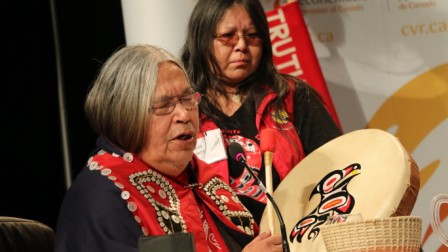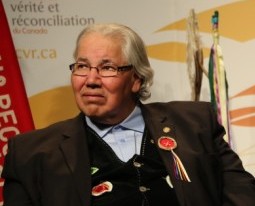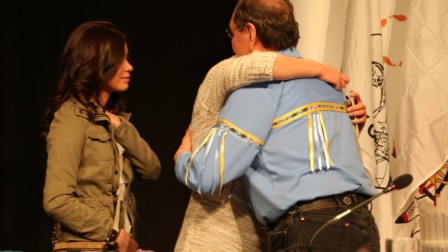In a genuine effort to uncover the actual truth of what happened in Canada’s Indian residential schools, and how to advance various forms of reconciliation, the TRC held its seventh and final National Event in Edmonton, Alberta, March 27 – 30.
According to staff members, the four-day gathering raised the bar as it established a new record for the most people at a single event in Edmonton’s Shaw Conference Centre with a standing room only crowd of 12 to 15 thousand people a day!
The Alberta-based event attracted more than 3,240 registered survivors in addition to friends, relatives and visitors from all across the country as well as the northern territories. Alberta had the most (25) residential schools of all the provinces and Edmonton is believed to be the home city of 12,000 of the approximate 75 – 80 thousand remaining survivors in all Canada.

Tom Humchitt makes his statement at the TRC National Event in Edmonton in March. (Story and photos by Terry Lusty)
The stories, or testimonies, of more than 400 individuals from this recent event is now a matter of record. Many are heart-wrenching, some are horrific, and others defy belief.
In the end, however, the emotionally-charged accounts are to be archived in Winnipeg as a lasting legacy of one of the country’s darkest periods, what innumerable survivors refer to as “the Canadian holocaust,” or “Canada’s shame.” Through the four days in both private and public hearings, one heard continual tales of abuse, neglect, denial, anger, bitterness, even genocide. And, yes, many tears flowed, voices quivered, bodies shook, and emotions ran amok. Despite the emotional toll, a good number of the presenters demonstrated remarkable strength, courage and compassion as they not only told their stories but even forgave their abusers.
Agnes Gendron from Saskatchewan, recalled her arrival at her school. Like all others, she was subjected to searing hot steaming followed by a cold shower. “I fainted, I just dropped,” she stated. “I saw horrific things,” such as other children with “their ears bleeding because they (staff) were pulling on their ears.
Debasing stories of inhuman treatment were also common. Gendron described how the children who wet their beds would be paraded in front of all the other children with their wet bed sheet pulled over their heads. One of those little girls was her own kid sister.
“I hated those people,” she mused. “I could feel the hair on my back stand up seeing my little sister with sad eyes and tears in her eyes and we couldn’t go over there and comfort her.”
Gendron went on to tell of how she and her siblings later resorted to alcohol to ease their pain. Eventually she broke that cycle. “After that,” she added, “all my siblings quit, one after another.
Now 42, Lionel Weaselhead from Kainai First Nation in southern Alberta shared how reclaiming his culture through ceremonial practices and spirituality worked for him. At Red Crow College on his reserve, they teach about culture and residential school. It’s making a difference, “taking back that responsibility,” he said to loud applause.
“What is so important, he continued,” is the need for facilities (living quarters) that are drug and alcohol free and give our people that support that they need.”
Survivor statements often detailed extreme loneliness and frequent crying spells of some. Such was the case of Terese Moberly. One incident she recalled was the night she was made to go to “a black car.” When she was inside, she was undressed but doesn’t recall all that transpired as she blocked it out. She did, however, remember that “this went on for a long time.”
On another occasion, Moberly once got lost and accidentally opened a door in the main building that she shouldn’t have. But she did, that was a mistake. “There was this priest on top of another person.” Young and innocent, she didn’t realize what was happening. The priest got very upset.
Moberly was also one of those kids who would pee the bed. Why? “Because I was scared to tell the nun I needed to go to the washroom.”
Brave soul that she was, Moberly managed to hold up despite having just lost her brother that same morning. What seemed to keep her going was her deep desire to dedicate her statement to her mother on her brother’s behalf. “I want him to know I am here for her (our mom),” she explained. She, too, attended residential school when she was young.
According to the chief of the Kamloops First Nation, Shane Gotfriedson, Aboriginals who survived residential school, and their communities have a lot going for them. To him, they are terrific role models for others.
“I know, if we all stand united like we are, supporting one another in Truth and Reconciliation, our government will be stronger,” he said. Through education and the caring exhibited in telling their stories, he stated, “this is a huge, huge step, not only for yourself, but in educating your own inner families.”
The helplessness and futility the young children experienced is legendary. The sexual exploitation they faced became a common story for many, including one Mathias Suganaquq. He was “very scared” when picked up in a bush plane. And when he got dropped off at a residential school, “I was very lost, very lonely,” he admitted.
With no command of the English language, he was often strapped for mispronouncing words. He’d have trouble sleeping and would get anxiety attacks. When he went home a year later, his mom noticed the difference in him. So, she kept him home. Unfortunately, she died a year later and Suganaquq found himself back in residential school.
“I couldn’t sleep, I couldn’t eat. I was sexually abused,” he complained. And the abuse took its toll.
“I was withdrawn, sad, depressed, ran away a few times and got in fights. That’s how you survived,” he concluded.
by Terry Lusty





Be the first to comment on "TRC event was filled with tears and testimony"